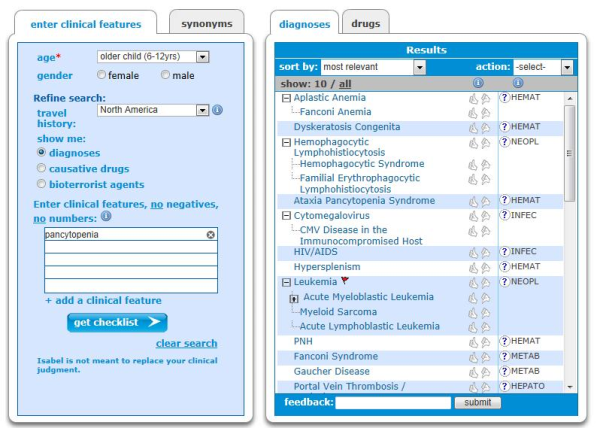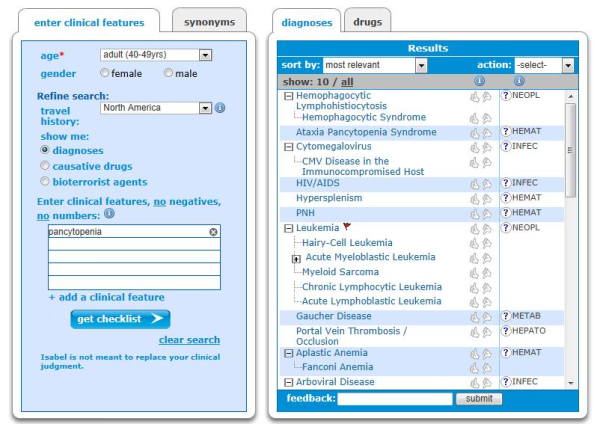- Privacy Policy
- Terms & Conditions
- Contact us
- ©Isabel Healthcare 2020
Pancytopenia Differential Diagnosis - Isabel Healthcare
Pancytopenia refers to the reduction or abnormally low level of all blood cells (erythrocytes (red blood cells), leukocytes (white blood cells) and platelets) produced by the bone marrow. It can occur due to decreased production of the blood cells, bone marrow failure, immune-mediated destruction or peripheral sequestration. A diagnosis of pancytopenia is made from analyzing a complete blood count.
Pancytopenia develops gradually and can present clinically as anemia, leucopenia and thrombocytopenia.
Pancytopenia (where the cause hasn’t yet been identified) requires urgent evaluation by a hematologist. A complete blood count and examination of the peripheral blood film should be performed.
Mild pancytopenia is normally symptom free and therefore discovered incidentally when performing a complete blood count. If a pancytopenia is more severe then the patient may experience mucosal bleeding, easy bruising, purpura and petechiae due to thrombocytopenia. A symptomatic anemia may then occur with classic anemia symptoms like fatigue and shortness of breath.
As can be seen from this differential diagnosis in a child the following diseases can be caused by pancytopenia:

Differential diagnosis of pancytopenia in a child
Aplastic anemia / Fanconi anemia – Occurs in ages 2 to 10 years and child may present with thrombocytopenia, leukopenia, pancytopenia, fatigue, spontaneous bruising, mucosal bleeding, fever and rigors. Other features which may be found on examination are short stature, structual abnormalities of limbs, eyes and ears, hyperpigmentation, café au lait spots, purpura or petechiae.
Dyskeratosis congenita is a progressive bone marrow failure syndrome that is characterized by reticulated skin hyperpigmentation, nail dystrophy, oral leukoplakia and pancytopenia. Patients generally present in the first decade of life with skin and nail changes.
Hemophagocytic lymphohistiocytosis may present with malaise, fatigue, erythematous skin rash, abdominal discomfort and pancytopenia.
Acute myeloid leukemia or Acute lymphoblastic leukemia could present with a rapid onset of fatigue, shortness of breath, fever, rigors and pancytopenia.

Differential diagnosis of pancytopenia in an adult.
An adult differential checklist for Pancytopenia will also take into account Paroxysmal nocturnal hemoglobinuria which may have symptoms of previous venous thrombosis, fatigue, intermittent abdominal pain, dark urine, blood in stool and pancytopenia.
HIV infection should also be ruled out especially if the patient presents with pancytopenia and a combination of fatigue, easy bruising, spontaneous bleeding, fever, rigors.
Autoimmune hepatitis may occur with symptoms of pancytopenia, fatigue, malaise, anorexia, nausea and pruritus.
Cytomegalovirus infection may include pancytopenia, fever, malaise, arthralgia, tender lymphadenopathy and pharyngitis amongst its symptoms.
Once you have constructed your pancytopenia differential and discussed with a hematologist, you can order tests such as vitamin b12 level, folate level, hemosiderin in urine, LDH, haptoglobin, parvovirus antibodies, HIV serology and ANA to exclude some of the differentials. If any of these tests prove abnormal then you can enter them into Isabel along with pancytopenia in order to refine your list of diagnoses. If these tests do not show anything then you should move onto the more invasive tests such as bone marrow biopsy and aspirate. A bone marrow biopsy can be aplastic or hyperplastic bone marrow. Pancytopenia and a hypoplastic bone marrow is seen in hypersplenism, myelodysplastic syndromes and myelophthisis. Aplastic bone marrow biopsy indicates aplastic anemia.

Mandy Tomlinson
Mandy has worked for Isabel Healthcare since 2000. Prior to this, she was a Senior Staff Nurse on the Pediatric Infectious disease ward and high dependency unit at one of London's top hospitals, St Mary’s in Paddington which is part of Imperial College Healthcare NHS Trust. Her experience in the healthcare industry for the past 28 years in both the UK and USA means she's a vital resource for our organization. Mandy currently lives and works in Scottsdale, Arizona.
Subscribe Here!
Recent Posts
Virtual Triage: Do more questions lead to better patient outcomes?
One of the common misconceptions related to virtual triage / symptom checker tools is that the more..Webinar: Using Virtual Triage To Transform Patient Access
Outdated contact centers are posing problems for today's health systems. As longer hold times..List Of Categories
- Differential Diagnosis Decision Support
- Differential diagnosis
- Symptom Checker
- Symptoms
- Medical Error
- Patient Disease Information
- Disease
- Diagnostic Decision Support
- Clinical Decision Support
- Isabel 1 Minute Read
- Diagnosis Error
- Diagnosis Skills Cases
- Healthcare Informatics
- Medical Education
- Patient Engagement
- Clinical Reasoning
- Evidence-based Medicine
- Symptom Triage
- Nurse Practitioner Education
- Nursing Decision Support
- Partnership
- Public Health
- COVID-19
- EHR
- Patient Empowerment
- Patient Safety
- rare disease

Start your FREE Trial today
Try the Isabel Pro DDx generator for 30-days - no payment card details required.




